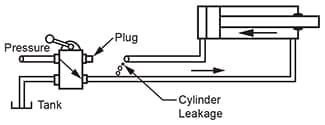Womack Data Sheet 68: Troubleshooting Tips for Open Loop Hydraulic Systems
| The following is a summary of troubleshooting tips and corrective measures for air and hydraulic systems which have appeared in preceding issues of these Design Data Sheets: Design Data Sheet 1 – How to estimate the size heat exchanger to add to a system in which recurring service problems are due to operation with overheated oil. Design Data Sheet 2 – How to measure the elements of a broken pump for selection of a new pump of the same displacement. Design Data Sheet 14 – How to increase the speed of an air cylinder which moves too slowly. Design Data Sheet 18 – Troubleshooting tips for valve solenoid coils which seem to burn out too frequently. Design Data Sheet 23 – Suggested remedies for minimizing shock in hydraulic systems. Design Data Sheet 30 – Additional information for finding the cause of too frequent burn-outs of solenoid valve coils. Design Data Sheet 45 – How to prevent water from condensing in your air lines. Design Data Sheet 48 – Troubleshooting tips especially for hydraulic pumps. Design Data Sheet 54 – How to correct drift problems in hydraulic cylinder circuits. Design Data Sheet 63 – Troubleshooting tips for hydraulic systems. Design Data Sheet 67 – Tips on troubleshooting a closed loop hydrostatic hydraulic system. |
Information in this issue supplements information principally in Design Data Sheets 63 and 67. We suggest a study of those sheets as a prerequisite for this issue.
Cylinder and 4-Way Valve Testing
The following is a more detailed procedure for Steps 6 and 7 in Design Data Sheet 63, after the pump and relief valve have been checked and found to be working OK.
The next step is to check out the cylinder and 4-way valve to determine the component responsible for by-pass of the pump oil to tank. Since the cylinder piston seals are the more likely cause, the cylinder should be checked first.

Diagram for Cylinder Testing
Step 6 – Cylinder
Disconnect one cylinder line from the 4-way valve and plug or cap the open valve port. Shift the 4-way valve in a direction to run the cylinder piston toward the open port. Let the piston stall, under pressure, against its end cap. Observe the volume of fluid, if any, which comes out of the open cylinder port. This is the fluid which is leaking past the piston seals. A small amount or seepage is normal in many systems. But if the seepage volume represents a large percentage of the total pumped oil, this is bound to affect system operation. Piston seals may simply be worn out or one of them may be twisted or distorted.
Re-connect the disconnected line, run the piston to the other end of the bore and repeat the above test. Except in the case of an O-ring seal, there are usually two sets of sealing rings on the piston, one for each direction of movement. One seal may be worn out, the other one good. Be sure to replace both piston seals.
Occasionally, a cylinder will lose power at one point in its stroke due to a deep scratch or dent in the barrel. Check any suspected mid-stroke position by blocking the piston rod to stall at the suspected position and make the test as described above. Cylinders with this kind of damage are usually considered to be economically unrepairable.
Once in a while a piston seal may leak intermittently. This is usually caused by a soft packing or O-ring moving slightly, or rolling or twisting in its groove. A standard O-ring should not be used as a moving seal on large bore cylinders, say more than 4” diameter, because of its tendency to twist in the groove and open up a large leak passage.
Step 7 – Directional Control Valve
After the cylinder has been checked and found to have reasonably tight piston seals, the 4-way directional valve should next be checked. Although it does not happen often, an excessively worn valve spool can slip enough oil to affect system performance. Symptoms of this condition would be a loss of speed at the higher pressures. The system might be slow in building up full pressure. Performance would be affected to a greater degree when using a low volume pump operating at high pressure. Four-way valves can be tested for spool leakage as follows:
Disconnect both cylinder lines between valve and cylinder and plug or cap the open valve ports and the ends of the lines. Shift the valve spool from one side position to the other while under pressure. Any flow which comes out of the valve exhaust port while the spool is in a side position is spool leakage.
Small valves may cost more to repair than the valve is worth. On large valves it may be economical to recondition the valve by replacing the spool. The body bore should be accurately measured and an oversize spool should be ordered. This spool must be lapped into the valve body by the user.
Pilot-Operated Solenoid Valves
A special problem sometimes develops with these valves. Energizing a solenoid will not cause the spool to shift unless there is a minimum level of 50 to 100 PSI hydraulic pilot pressure either on the valve inlet or on the external pilot port “X” on the valve subplate. If this pilot pressure is lost either partially or wholly, the spool cannot be shifted out of center position.
If the valve will not shift when a solenoid is energized, assuming the pump and relief valve are working OK, first check to be sure voltage is being applied to the coil and that the coil is not burned out. Then, install a low range pressure gauge to measure pilot pressure level at the valve inlet port. If the pilot pressure level is marginal when the oil is cold, it may drop below the workable level when the oil heats up.
A more detailed discussion of pilot pressure for a solenoid controlled, pilot-operated 4-way valve will be found in the Womack book “Industrial Fluid Power – Volume 2.”
Summary of Test Procedure
The frequency of occurrence of various types of breakdown troubles is:
(1), Cavitation of the pump inlet caused by a dirty suction strainer. (2), Cylinder piston seals worn out. (3), A pilot-operated relief valve sticking or malfunctioning because of dirt accumulation.
Cavitation, (1), can usually be identified because of the unusually high pump noise level, and an unusually high pump case temperature.
Leaking piston seals, (2), can sometimes be detected by an unusually high temperature rise in the cylinder barrel.
Sometimes, slippage troubles can be detected quickly by feeling the temperature at various places on the components and plumbing. Before any lines are disconnected, the temperature on the outside of all components and plumbing should be checked by touch.
CLOSED LOOP HYDROSTATIC SYSTEMS
The following information supplements the troubleshooting tips for closed loop systems given in Design Data Sheet 67, and deals with the problem of high oil temperature and overheating of the pump and motor.
If high oil temperature should be observed on a transmission which previously has been operating at an acceptable temperature, check for these possible faults:
1. Overheating may be a normal condition for the season. A system which runs at an acceptable temperature in the wintertime may overheat in hot weather. It may be necessary to add heat exchanger capacity, adding a second heat exchanger or substituting a larger one. Or, an improvement may be possible by re-routing additional oil through the existing heat exchanger.
2. Heat Exchanger. Check water supply volume and temperature on shell and tube heat exchangers. Also check to be sure water modulating valve is opening properly. On air blast heat exchangers check for restrictions to air flow such as dirt or other foreign material lodged in the fins. Check to see if reservoir is exposed to direct rays of sun. Add a sun shield in such a way that it does not interfere with normal upward air flow around the sides of the reservoir. Check air blast heat exchangers for slipping fan belts (on electric motor driven fans), dirty or excessively oily exterior, direction of fan blade rotation, etc.
3. High Pressure Relief Valves. Usually there are two of these valves, one for each direction of hydraulic motor rotation, and they are located either on the motor cover or in an external package. Any oil discharge across these valves must be only momentary to relieve momentary pressure spikes which may pass through the system. At no time should a steady discharge be permitted across these valves. The pressure compensator associated with the pump normally maintains control of maximum pressure. To prevent a sustained discharge across the high pressure relief valves they should be set about 500 PSI higher than the setting of the pressure compensator. If one or both of these valves has been set close to or less than the compensator, this may cause severe overheating. When setting the relief valves, follow procedure described in your service manual.
4. Charge Pump Check Valves. There are two internal check” valves, located in the pump housing, which feed low pressure from the charge pump into the side of the loop which is at the lower pressure. If either of these check valves should develop a serious leak, this would permit some of the high pressure oil in the loop to leak back into the low pressure charge pump circuit to discharge across the low pressure relief valve. The result might be a loss of motor torque or speed plus abnormal heating of the oil.
5. Shuttle Valve. The shuttle valve is usually located in We motor cover. Its purpose is to keep the low pressure relief valve (also located in the motor cover) connected to discharge into the motor case to help carry away heat from the motor. If it should develop a serious leak, some of the high pressure loop oil would escape into the motor case and to tank. This would generate additional heat.
On mobile equipment it is often very difficult to provide cooling for the transmission. A hydraulic oil cooling radiator may be mounted in front of the engine radiator to take advantage of the engine fan blast. On these difficult applications it is important to keep hydraulic tank and components shielded from direct sunlight and to change oil more frequently than in a well-cooled system, perhaps several times a season on hard-working equipment.
Case Drains on a Hydrostatic Transmission
The case draining arrangement which provides the greatest amount of cooling to the transmission is one in which (a), the low pressure relief valve, located in the motor cover, discharges into the motor case through a shuttle valve, then (b), the case drain of the motor connects to discharge into the pump case. A second drain port on the pump then, (c), carries the combined drain flow of pump and motor to tank through a heat exchanger.
In some cases it may be possible to re-connect case drains as described above to help carry pump and motor heat more effectively to the heat exchanger for disposal.
© 1990 by Womack Machine Supply Co. This company assumes no liability for errors in data nor in safe and/or satisfactory operation of equipment designed from this information.






